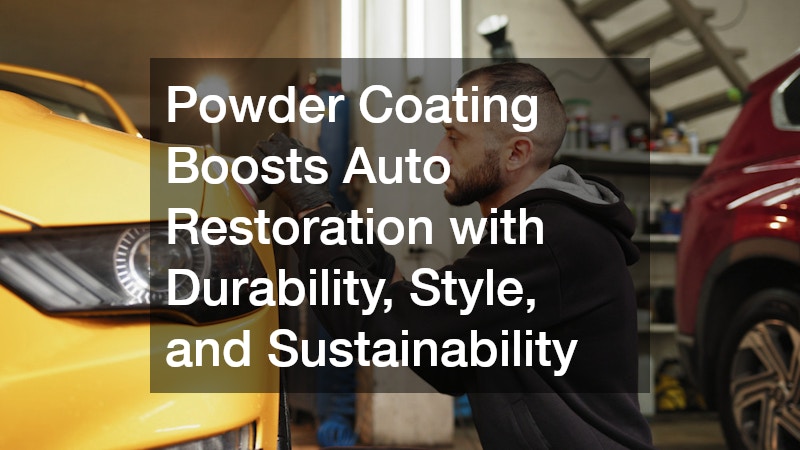
Powder coating has become a pivotal advancement in the field of auto restoration, turning it into a game-changer within the industry. This approach not only enhances the aesthetic value of restored vehicles but also significantly boosts their durability and energy efficiency. In the following sections, we will delve into the myriad of ways powder coating has revolutionized auto restoration, examining both its technical advancements and inherent benefits. Embracing powder coating can transform the restoration process, challenging traditional methods that have long dominated the market.
What is Powder Coating and Why is it Preferred in Auto Restoration?
Understanding the Powder Coating Process
The powder coating process involves applying a dry powder, typically composed of polyester or epoxy, which is electrostatically charged and sprayed onto metal surfaces. Once applied, the coated vehicle parts are cured under heat, creating a durable, protective finish that bonds to the metal.
Unlike traditional liquid paints, powder coatings provide a thicker, uniform coverage capable of withstanding environmental stressors. The technology utilized ensures that each vehicle part gains a smooth finish with superior adhesion, making it an ideal choice for premium auto restoration.
This innovative coating technique eliminates the need for solvents, resulting in a more environmentally friendly option. As environmental protections become increasingly important, powder coating emerges not only as an effective solution but also as a sustainable choice for restoration purposes.
Benefits of Using Powder Coating over Traditional Methods
One of the foremost advantages of powder coating is its exceptional durability, offering enhanced resistance against chipping, scratching, and fading. The final product is a resilient surface that outperforms traditional paint methods, keeping vehicles in pristine condition for longer periods.
The finish quality provided by powder coatings is unparalleled, delivering a smooth and even coating that enhances the aesthetic appeal of restored vehicles. Unlike conventional paints, which may run or leave brush marks, powder coatings create a flawless finish with consistent color.
Additionally, powder coating reduces the environmental impact by avoiding volatile organic compounds commonly found in traditional paint. It is a more sustainable choice, supporting eco-friendly practices in the auto restoration industry without compromising quality.
How Does Powder Coating Enhance Vehicle Longevity?
Increased Resistance to Corrosion and Wear
Powder coating significantly bolsters a vehicle’s resistance to corrosion, making it a valuable method for extending the lifespan of auto parts. The coating acts as a formidable barrier against moisture, reducing the risk of rust and corrosion, particularly in environments prone to humidity and temperature fluctuations.
Moreover, the resilience provided by powder coatings guards against general wear and tear, ensuring that vehicle parts maintain their integrity over time. This durability not only enhances the vehicle’s performance but also preserves its aesthetic appeal.
Besides its protective qualities, the application process ensures full coverage of intricate parts, leaving no area susceptible to corrosive agents. By adopting powder coating, restoration experts can significantly reduce maintenance requirements and prolong the service life of a vehicle.
Cost-Effectiveness Over Time
Though the initial investment in powder coating might be higher compared to traditional painting methods, the long-term cost savings are substantial. By reducing the need for frequent repaints and repairs, the overall maintenance costs associated with traditional paints are diminished.
This efficiency not only cuts back on resources dedicated to upkeep but also ensures a higher resale value for restored vehicles. As a result, vehicle owners can see a return on their initial investment through sustained quality and appearance.
Moreover, the enhanced longevity and reduced degradation over time lead to fewer replacements of parts, contributing to substantial economic benefits in the realm of auto restoration. When considering all associated costs, powder coating emerges as a financially viable option.
Is Powder Coating Suitable for All Auto Restoration Projects?
Applicability to Different Vehicle Types
Powder coating is a versatile technique that can be applied to a wide range of vehicles, from classic cars to modern automobiles, particularly beneficial for parts subject to high stress. The method is especially advantageous for refurbishing parts like wheels, frames, and engine components that demand durability.
Although it is widely applicable, certain materials and designs may require specialized considerations. The non-conductive nature of powder may limit the process for specific non-metal components unless pretreatment measures are taken.
Nonetheless, the adaptability of powder coating makes it suitable for an extensive range of restoration applications, validating its status as a versatile and reliable solution in auto refurbishment projects.
Limitations and Considerations
While powder coating is an excellent choice for many applications, it is essential to consider specific limitations, such as the inability to coat very thick components evenly. This necessitates expertise in preparation and application to achieve the best results.
Additionally, the upfront equipment cost may deter small-scale operators or hobbyists. Understanding these factors allows restoration powder coaters to navigate challenges efficiently.
Despite these considerations, when strategically approached, powder coating provides unmatched protective qualities and contributes positively to the sustainability of restoration practices.
Powder coating stands out as a transformative tool in the auto restoration industry, bringing unparalleled benefits of durability, aesthetic perfection, and environmental sustainability. Its ability to enhance the longevity and appearance of vehicles offers a compelling case for its widespread adoption.
As we look to the future, innovations in powder coating technology promise even greater efficiency and less environmental impact. For restoration professionals seeking advanced solutions, powder coating undoubtedly represents the way forward in high-quality auto restoration.




